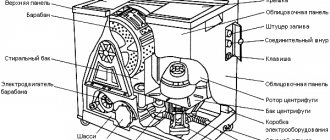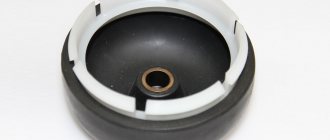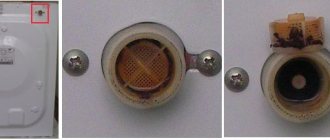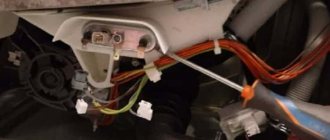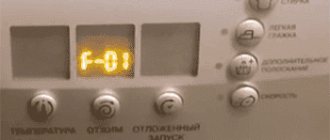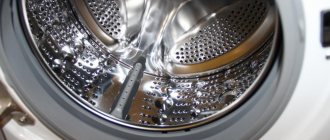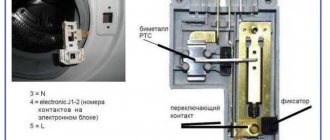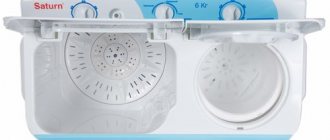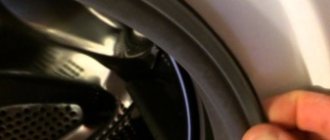Semi-automatic washing machines are simple and reliable. They are inexpensive and therefore are in small but constant demand among consumers. However, simplicity of design means the use of circuits for which the issue of failure is measured only by time and frequency of operation. One of the problems that arise with semi-automatic machines is problems with the centrifuge. Let's figure out why the centrifuge in a semi-automatic washing machine does not work, and how to fix it.
Why centrifuge breakdowns happen most often
The centrifuge in a semi-automatic washing machine can rightfully be considered the weakest part of the design. This unit is made as simple as possible. The tank is directly connected to the motor shaft. Only the seal protects against short circuits due to water ingress. It is attached to the tank and is subject to constant wear and tear.
The oil seal fails not only due to frequent use of the wringer. It can deteriorate when the device is idle. That is, the rubber becomes rougher, and when it dries out, cracks form on it. As a result, leaks occur, which can result in a short circuit of the engine.
There is one important detail here. If such a breakdown occurs, it is not only the drive that needs to be replaced. A new oil seal will have to be installed along with the engine. This is the only way to protect against leaks and repeated breakdowns.
Oil seal for semi-automatic washing machine
There are similar problems in other components of the semi-automatic machine. And we can confidently say that they arise due to a simplified design. For example, there are difficulties with draining water. For the simple reason, there is no filter at the pump inlet, and the valve cannot cope with a large amount of contaminants. There are also difficulties in the operation of the washing unit. In particular, the gearbox may fail due to leaks in a worn oil seal.
What is an oil seal and where is it located?
The oil seal is a part that serves as a seal between the two halves of the mechanism. One of these parts is fixed permanently, and the other is movable. Most often, the oil seal is made of rubber. Thus, it makes the connection not only tight, but also airtight.
As you already understand, the washing machine also has an oil seal.
Where is he located? Let's take an example of a front-loading washing machine. The drum of such units is located on a special bracket, in the middle of which there is an axle shaft made of steel. The drum and tank of the washing machine are attached to the axle shaft through bearings. This is where you need to look for the oil seal. It is located not on the shaft itself, but on a special bronze bushing. This “pair” ensures normal operation of the unit and protects the bearing from water ingress. Such protection is very important, because if moisture gets in, the bearing quickly collapses and becomes covered with rust. See also -
How to remove or disassemble a washing machine drum at home
Why doesn't the centrifuge drum spin?
The centrifuge drum most often does not spin or does so slowly for two reasons.
- The engine starting capacitor is broken, dried out, or otherwise damaged.
- The brake cable has become loose.
The capacitor can only be checked with a special device. Therefore, the easiest way is to replace this element with a new one with a rated capacity. An indicator that such repairs need to be made looks like a strained, leisurely start. The set of revolutions is slow, and the tank does not spin up to the set rotation speed.
Diagram of a semi-automatic washing machine with a centrifuge
The cable is checked by rotating the drum. To do this, close the lid or close the control limit switch. Then you need to try to turn the centrifuge drum. If it turns with force, it is necessary to restore the cable tension.
When both checks fail, you should carefully inspect the drum. If there are streaks on it, most likely moisture has entered the engine. This means that the drive needs to be replaced. And don't forget to install a new oil seal. If the drum is visually clean, you should move on to checking the contacts. Unfortunately, many manufacturers offer unreliable connection options. And the wiring tends to oxidize.
How to lubricate the oil seal?
If you decide to replace the oil seal and bearings yourself, you should pay close attention to such a process as lubrication. For this, it is best to use special lubricants recommended by the manufacturer.
First of all, lubricant is applied to the outer side of the oil seal. An even thin layer is enough here. Then we move on to the interior. There is no need to save lubricant here, because it is in this part that the greatest friction will be observed.
Since special lubricant for the oil seal can be quite expensive, many craftsmen use Solidol, Litol, Azmol and other options used in car repairs. It's better not to do this. Although such a lubricant costs an order of magnitude cheaper, the savings here are quite doubtful. The fact is that “non-core” substances soften the rubber from which the oil seal is made. As a result, it deteriorates much faster and within a year or two you will have to replace it again.
How to disassemble the machine
Semi-automatic machines are almost like two peas in a pod. Of course, if we consider the key design features and methods of arranging components inside the case. Therefore, a person who has successfully disassembled and reassembled one machine can, with a high probability, correctly carry out the same work on another.
The general algorithm of actions looks like this.
- Remove bolts and screws from the entire body of the device. Finding them can be quite difficult. Many manufacturers place mounting points deep within the body. Therefore, it doesn’t hurt to stock up on a long screwdriver.
- Disconnect the centrifuge drum brake units and the water drain valve. To access them there is a hole in the rear of the machine.
- Unlock the centrifuge shaft.
It is worth dwelling on the last operation in more detail. The shaft bolt is secured with a locknut. To work, you will need a simple socket wrench. The nut is loosened, after which the bolt can be removed. At the end of this operation, it is necessary to fold back the entire upper part of the housing. This will have to be done with effort. To avoid damaging anything, it is recommended to pull with a rocking motion to release stubborn elements or corroded surfaces.
Safety sensor malfunction
In some models, for example, Saturn or DAEWOO (Daewoo), a sensor is installed on the door that closes the centrifuge tank. It is designed to disable the device from starting when the door is open. To get to this sensor, you will have to remove the top panel of the washer.
Under it you will see a sensor with two contacts that need to be wiped with cotton wool and alcohol. Do not scratch the contacts with a knife or sandpaper. Check sensor operation. When the lid is closed, the contacts should close.
Timer problem
The timer in most semi-automatic washing machines (SMP) is located under the top panel of the unit. It can be repaired by cleaning the contacts.
After removing the top panel, you will see a device that resembles a clock with gears. Inside it you can see contacts, which can burn out during prolonged use of the unit. Soot appears on them, preventing current from passing through.
You need to disassemble the timer carefully. The mechanism cover also serves to attach gears to it. After unscrewing the three screws, it must be removed so that the gears do not fall out. If you are afraid that you may not remove the cover carefully, then it is better to photograph the mechanism. After opening the cover, you will see the contacts. As with the sensor, they must be wiped with alcohol.
Choosing the “right” lubricant
There are several criteria that can influence the selection of a good oil seal lubricant. To meet all requirements, it must be:
- heat-resistant - due to the friction of the shaft and oil seal, it heats up, the lubricant must not lose its qualities as the temperature rises;
- moisture resistant - water periodically gets onto the oil seal along with washing powder dissolved in it;
- non-aggressive - the correct lubricant should not react with the rubber from which the oil seal is made;
- thick - the correct consistency of the substance should be such that it does not leak during operation.
It is best to use a special silicone lubricant for the job. Titanium will also work. They meet all the necessary requirements. It is best to purchase them at a specialized retail outlet, one that sells spare parts for washing machines. If silicone is not on sale, an experienced seller will tell you what to replace it with.
See also:
- 5 Best Whirlpool Washing Machines Based on Customer Reviews
- 6 best Bosch washing machines according to customer reviews
- 7 best Indesit washing machines according to customer reviews
- 7 best LG washing machines
- 7 best Gorenje washing machines according to customer reviews
Brake pads
How does the braking system work in semi-automatic cars? Brake pads are installed under the centrifuge and provide braking when the door is opened. It is connected to the lid via a cable. When the lid is opened, the cable is tensioned and the brake pads grip the rotating part of the engine - the centrifuge is braked.
You should open the rear wall of the SMP and check the tension of the cable and that the pads are not touching the engine when the door is closed. It is the contact of the brake pads that sometimes prevents the electric motor from starting.
Why does the oil seal fail?
As you already understood, the oil seal is an intermediary between the drum and the shaft on which it is attached. When rotating, the shaft is constantly in contact with the inside of the oil seal. The friction that occurs causes the part to wear out quite quickly. To prevent this from happening, the oil seal must be well lubricated.
However, no matter how wonderful the lubricant is, under the influence of soapy water seeping in during washing, it is gradually washed out. The seal dries out and begins to leak water to the bearing, which also becomes unusable.
Motor winding
A common cause of centrifuge failure is the burnout of one of the electric motor windings. You can check this using a tester (measuring device).
- We find the ends of the wires coming out of the electric motor. Usually there are three of them: the first is common, the second is leading to the starting winding, and the third is leading to the working winding. The common wire is marked with the letter “N” (often blue).
- We set the resistance test on the device and measure it between the blue wire and one of the two, for example, the red one. If resistance readings are present on the device screen, then everything is in order with this winding.
- We continue the same actions with another pair, blue and white wires. We measure the resistance and look at the readings of the device. If there is no resistance, then the winding has burned out. And the reason that the centrifuge in your semi-automatic washing machine does not work lies in the malfunction of the electric motor.
In such cases, the motor is either handed over for rewinding, or a new one is purchased and installed.
Other causes of failure
It is difficult to list all the causes of spin system breakdowns. Each model of machine may have its own nuances. Repairing a semi-automatic washing machine yourself will save you a lot of money. Here are the most common errors in the operation of the spin system.
- The motor makes a humming noise, but the spin cycle does not work. This means that the belt connecting the motor and centrifuge pulleys has slipped or broken.
- If, after checking the motor with the device, you are convinced that it is working properly, then the cause may be a faulty thermal relay or step-down transformer. These parts are replaced with new ones without repair.
- Check to see if there are any small things wrapped around the motor shaft that could fly out during the spin cycle and get inside the machine.
- Unevenly laid laundry in the rotor causes the centrifuge to beat and prevent it from starting.
- If the activator and spin motors do not work, check the fuse located inside the machine behind the rear wall. It would be a good idea to disassemble the electrical plug and check the contacts.
